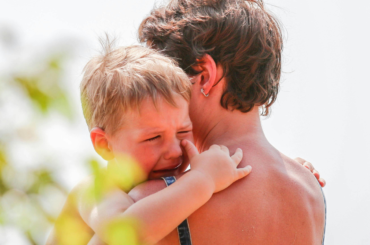Even though we’ve all adjusted to some new rhythms this summer, our kids may still be struggling with the strain of coping with the Coronavirus pandemic. We’re all probably feeling the stress of this unique time, whether that’s from adjusting to health precautions, feeling financial pressure not having our childcare centers open, or our kids being unable to spend time with friends. Mostly, there’s a lot of uncertainty right now, which can certainly increase any family’s anxiety level. And whether kids are aware of it or not, they pick up on the anxieties of family members and may have their own worries about what will happen as we move through the challenges of the Coronavirus.
How might kids’ anxiety show up right now?
One common symptom of kids’ anxieties that you might be seeing is ongoing regression—that is, noticing your child slipping back into behaviors that they’ve outgrown. You may be noticing more tantrums, defiance and attention-seeking behavior. Younger kids might backtrack in their potty training progress, start sucking their thumb again, or seem to lose recent gains toward developmental milestones. Kids of any age may also be acting more dependent on you than usual, or waking at night (maybe even trying to join you in bed).
Regressions like these are normal, and a perfectly natural response to anxiety and change. “ “Children who are stressed almost always regress,” says Dr. Laura Markham, Clinical Psychologist at Columbia University and founder of Aha Parenting. “Regression means that the child is not able to cope in as mature a manner as they have recently mastered, because they feel too overwhelmed.” Kids are like silent detectives—they know when something is going on in their surroundings that makes them uncomfortable, and their behavior is the way they let us know. Regression can simply be a healthy way for your child to meet their emotional needs when they’re overwhelmed. Sometimes it’s just their way of saying “enough!” or asking you for your attention.
What strategies are best to try with my child?
Acknowledge. First, acknowledge the feelings your child is having so that you can talk with and support them. In order to explore anxieties or worries, be careful to respond to emotions, not just to behaviors—so rather than scolding your child for refusing to do something you know they’re perfectly capable of, take a moment to say, “You seem like you’re having a really hard time right now. Can I help?” Remember that the behavior is the symptom; the emotion is the cause. Help your child name the emotion that’s underneath the reaction. Kids as young as three can name specific feelings, and the simple act of naming those feelings can help them feel less overwhelmed. Consider engaging in creative play, such as by using stuffed animals to act out scary situations or worries, to give them a way to share their feelings with you.
Shift the mood. Being able to shift a child’s mindset is a powerful tool for parents. One strategy to use with kids of any age when they feel worried is to help them shift their thinking in a positive direction. For example, try making a list together of good things. Also, encourage a mindset of acceptance. Remind your child that you love them, no matter what they are feeling. And don’t forget the power of a good laugh to bring some lightheartedness or silliness in to keep the worry company. The positive connection will not only change the mood, but will also help make your child feel more secure, which helps relieve anxiety.
Regulate. Another thing parents can do is what psychologists call “co-regulate” with our kids. That is, help them take steps to calm down or feel comforted when they’re upset or emotionally reactive. Regulation can happen through physical movements together (dance party!) or even by taking a mental vacation where you each take turns adding some details to your special imagined destination. Co-regulation is good practice in teaching your child to self-soothe so they develop the ability to regulate on their own. For example, encourage toddlers to tuck their worries into their pocket, or teach them how to breathe their worries out (you can even catch them and set them free).
The same strategies can work with older kids, too. Next time your book-loving ten year old insists that she can’t read alone, rather than digging in your heels (because, sure, you’re still cleaning up from dinner), dig a little deeper. It’s probably her way of asking for your attention. Take a 10-minute break from what you’re doing and read together. Then, pause and start a conversation about what she’s feeling.
Is your child’s behavior related to family anxiety or stress?
It’s hard to know for sure, but checking in with yourself and your own level of stress is a helpful first step. Consider the tone of conversations about uncertainties and worries that you are having as a family. Though there’s no need to shelter older kids from difficult topics, be sure that you’re paying attention to your body language and word choice when your kids are around.
How to stay ahead of the stress curve
Parents have the challenge of needing to honor their own needs while trying to meet those of their kids, and for many that’s harder now than ever. One simple thing you can do is make an effort to get to know your body’s own stress language. When our body’s stress response system gets activated, sometimes our so-called “higher functions,” like thinking rationally and communicating thoughtfully, are pushed aside by our desire to feel safe and soothed—and this is as true for toddlers as it is for parents. So when your rational brain gets hijacked by a stress reaction (the “fight or flight” reaction), you’re also more likely to act instinctually, or in a way that is based on fear or worry. The first step is to notice it. Pay attention to when your thoughts start to race, your breath becomes more shallow, or your heartbeat speeds up. Practice deep breaths, try to relax your body and pause before you speak to your kids so that you’re mindful of not passing your own stress signals along to those little detectives.
So, what’s the upshot?
When kids’ routines are disrupted, or they feel uncertain or worried, their behaviors often show us their discomfort (here’s our post on ways to decode kids’ behavior at any age). When you need a new strategy for helping an anxious kid navigate what’s worrying them, try on some of the phrases we suggest in this article. And, at the end of the day, know that taking good care of yourself and attending to your own wellbeing is a great place to start to unravel family anxieties.







